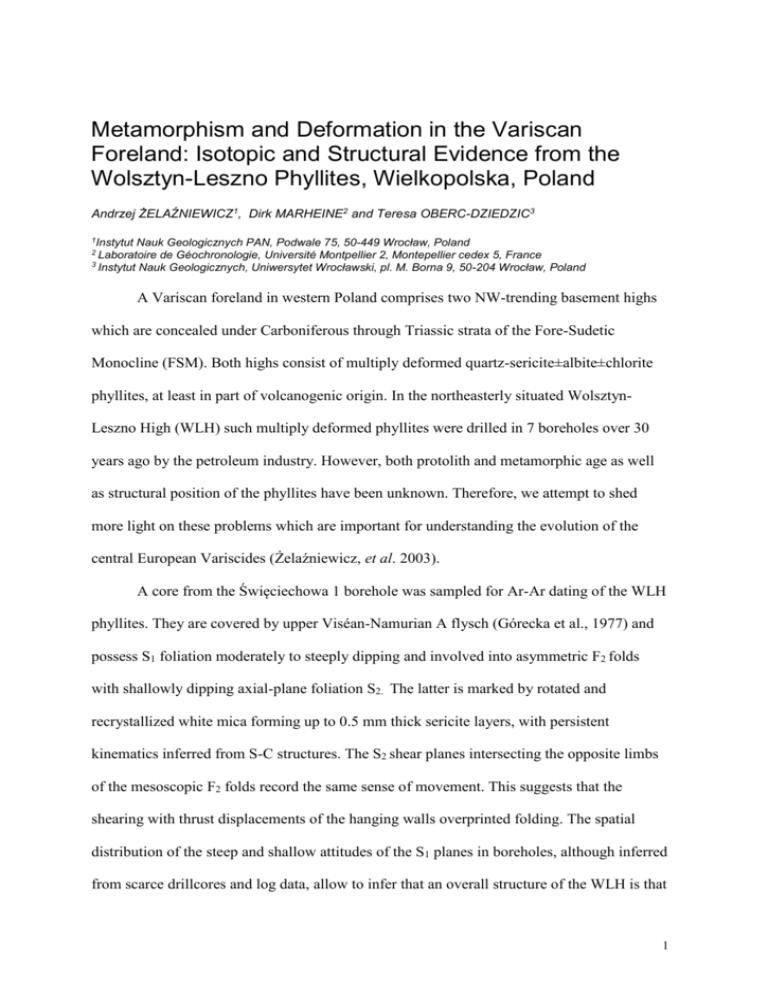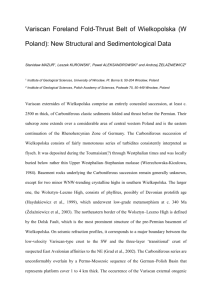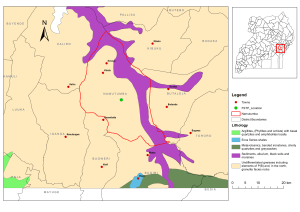the Wolsztyn-Leszno High, western Poland
advertisement

Metamorphism and Deformation in the Variscan Foreland: Isotopic and Structural Evidence from the Wolsztyn-Leszno Phyllites, Wielkopolska, Poland Andrzej ŻELAŹNIEWICZ1, Dirk MARHEINE2 and Teresa OBERC-DZIEDZIC3 Nauk Geologicznych PAN, Podwale 75, 50-449 Wrocław, Poland de Géochronologie, Université Montpellier 2, Montepellier cedex 5, France 3 Instytut Nauk Geologicznych, Uniwersytet Wrocławski, pl. M. Borna 9, 50-204 Wrocław, Poland 1Instytut 2 Laboratoire A Variscan foreland in western Poland comprises two NW-trending basement highs which are concealed under Carboniferous through Triassic strata of the Fore-Sudetic Monocline (FSM). Both highs consist of multiply deformed quartz-sericite±albite±chlorite phyllites, at least in part of volcanogenic origin. In the northeasterly situated WolsztynLeszno High (WLH) such multiply deformed phyllites were drilled in 7 boreholes over 30 years ago by the petroleum industry. However, both protolith and metamorphic age as well as structural position of the phyllites have been unknown. Therefore, we attempt to shed more light on these problems which are important for understanding the evolution of the central European Variscides (Żelaźniewicz, et al. 2003). A core from the Święciechowa 1 borehole was sampled for Ar-Ar dating of the WLH phyllites. They are covered by upper Viséan-Namurian A flysch (Górecka et al., 1977) and possess S1 foliation moderately to steeply dipping and involved into asymmetric F2 folds with shallowly dipping axial-plane foliation S2. The latter is marked by rotated and recrystallized white mica forming up to 0.5 mm thick sericite layers, with persistent kinematics inferred from S-C structures. The S2 shear planes intersecting the opposite limbs of the mesoscopic F2 folds record the same sense of movement. This suggests that the shearing with thrust displacements of the hanging walls overprinted folding. The spatial distribution of the steep and shallow attitudes of the S1 planes in boreholes, although inferred from scarce drillcores and log data, allow to infer that an overall structure of the WLH is that 1 of a large-scale overturned fold related to thrusting. Direction of thrusting remains unknown because the drillcores were not orientated. However, subcrop outline and gravimetric data show that the WLH stretches NW-SE. The dipmeter data for boreholes penetrating Carboniferous successions on either limb of the WLH document SW-ward dips of Upper Viséan-Lower Namurian flysch beds (unpublished petroleum industry data). Accordingly, NW-trending structural grain of the phyllites and similar SW-ward regional dip of their foliations are supposed. Combining all these data with a minute stretching lineation of quartz (L2q) present on the S2 foliation planes, which matches the dip- to oblique-slip motion, it is inferred the studied Świeciechowa borehole drilled the inverted fold limb of a large-scale fold overprinted by thrusting with top-to-the N kinematics. It is the very limb that was sampled for the Ar-Ar age determination. The sample for analyses was prepared in the way permitting to measure isotopic ratios for the sericite flakes forming the S2 layers. Since most of the measured isotopic ratios are very similar yielding ages between 346 and 337 Ma, we assume that all the dated sericites grew inside the S2 layer, and the S1 micas could hardly escape resetting.The dated sericites are estimated to have grown below or close to the blocking temperature of argon in white mica (350 ± 50°C). Therefore, the growth ages of the S2 synkinematic micas and the age of the F2 folding and development of the S2 foliation has most probably been obtained. Taking into account the error in estimation of temperature conditions during D1 and D2 which is within the same limit and because of good structural constraint on the studied S2 mica layer, we suggest that the obtained age of 340.1±2.6 Ma dates the lower greenschist facies metamorphism and most probably refers to the D2 folding and shearing rather than to poorly constrained D1 event, or to post-D2 cooling. 2 The results of this study allow to suggest that in earliest Viséan times the pre-Viséan basement rocks of the Variscan foreland basin between the Odra Fault Zone and the Dolsk Fault Zone underwent large-scale, N/NE-vergent folding under the low greenschist facies conditions and by consecutive thrusting were transported away from the inner part of the orogen over the distance of some tens of kilometres and eventually brought to the surface on the listric faults in the hinge regions of major thrust-related folds. These folds form now the two observed phyllitic highs of Bielawy-Trzebnica and Wolsztyn-Leszno, which probably controlled the late Viséan through Permian topography and shed clasts to two foreland sequences of late Viséan-Namurian A age and Westphalian B-C age, respectively (Kłapciński & Lorenc, 1984; Żelichowski 1983, 1995). The upper Carboniferous strata were only britllely deformed, in a thin-skinned fashion, by folding thrusting and normal faulting in post-Westphalian C times. References GÓRECKA T., JUROSZEK C., KARWOWSKI L., KŁAPCIŃSKI J., LORENC S., MIERZEJEWSKI M., SACHANBIŃSKI M. and ŚLUSARCZYK S. 1977. Utwory skalne podłoża permu zachodniej części monokliny przedsudeckiej i perykliny Żar oraz przyległej części bloku przedsudeckiego. Prace Naukowe Instytutu Górnictwa Politechniki Wrocławskiej, 22: 3–92. KLAPCINSKI J. and LORENC S. 1984. Osady karbonu na południe od Poznania. Carboniferous sediments S of Poznań. Acta Universitatis Wratislaviensis. Prace Geologiczno-Mineralogiczne, 9: 19–33. ŻELAŹNIEWICZ A., MARHEINE D. AND OBERC-DZIEDZIC T. 2003. A Late Tournaisian synmetamorphic folding and thrusting event in the eastern Variscan foreland: 40Ar/39Ar evidence from the phyllites of the Wolsztyn-Leszno High, western Poland. International Journal of Earth Sciences, (in presss). ŻELICHOWSKI A. 1983. Lithological associations in the Carboniferous in Poland. Przegląd Geologiczny, 6: 342–350. ŻELICHOWSKI A. 1995. Occurrence of Carboniferous rocks and palaeotectonic conditions of sedimentation in the area of Poland – Western Pomerania and central Poland. In: A. Zdanowski and H. Żakowa H. (Editors), The Carboniferous System in Poland. Prace Instytutu Geologicznego, 147: 14–17. 3








